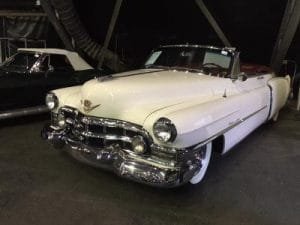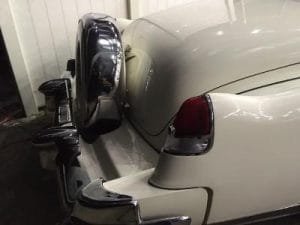
Featured here is a true classic and stunning 1952 Cadillac Convertible.
The 1952 convertible was the classiest Cadillac produced until the Eldorado was introduced the next year. The 1952 model year was also the 50th anniversary for Cadillac which was named for the French explorer who founded what is now the city of Detroit, Michigan.You will notice the gold emblem on the models front and rear commemorating the 50th anniversary.
There is no question that many of the Cadillac models produced during the 1950’s were beauties. Cadillac produced some great classics during the decade.
1952 Cadillac Series 62 Styling
A restyling for Cadillac came out for the 1950 model year. The restyling consisted of updates to the original 1948 design which itself was Cadillac’s first post war design. In short, the restyled cars appeared longer and overall bigger. Many would say that not including a few 1959-60 models the Series 62 Cadillac from 1950 to 1953 is Cadillac’s best post war examples of excellence in design.

The 1952 Cadillac had plenty of chrome which essentially outlined the automobile. The bigger and toothier grille was accompanied by massive bumpers. The Cadillac Series 62 also had chrome trim surrounding each window.
The 1952 Cadillac’s had tail fins. These small fins first came out with Cadillac’s new post war 1948 models. Legend has it that these rear fins were inspired by the tail section of the Army’s World War Two P-38 Lightning fighter bomber.
1952 Cadillac Series 62 Convertible Specifications
Engine for the 52 Cadillac was a 330 cubic inch V-8 with a four-barrel Carter or Rochester carburetor.. The 1952 Cadillac ushered in more power with this V-8 delivering 190 HP.
Transmission was a Dual Range Hydra-Matic three speed automatic. The Dual Range Hydra-Matic first came out in 1952 and offered two drive ranges. .
Brakes were four wheel hydraulic drums.
Suspension was a typical independent front suspension and rear semi-elliptic leaf spring.
Wheelbase was 126.0 inches, width 80.1 inches, overall outside length 215.5 inches. New car price in 1952 was about $3,900.
1952 Cadillac Convertible Coupe production was about 6,400 units. There were a total of just over 70,000 Series 62 models produced. That 70,000 figure was more than Packard’s entire 1952 production.
Related Auto Museum Online articles can be found on the links below..
Reference material for this article includes..The Cadillac Story: The Post War Years by Thomas Bonsall...Cadillac: The Tailfin Years by Robert J. Headrick Jr.. Cadillac Classics Car Club.
The 1952 Cadillac Series 62 Convertible Collector Car
 The 1952 Cadillac model stand out as classic cars that commemorated 50 years for the brand. The limited edition Golden Anniversary Eldorado model would come out for the 1953 model year.
The 1952 Cadillac model stand out as classic cars that commemorated 50 years for the brand. The limited edition Golden Anniversary Eldorado model would come out for the 1953 model year.
Current collector car prices for the 1952 Cadillac Series 62 Convertible in excellent condition, relatively low miles and high originality can be found at about $65,000 and higher. The very popular Series 62 Convertibles in like condition from 1951 through 1952 are all at asking prices like these.
(Article and photos copyright Auto Museum Online)
